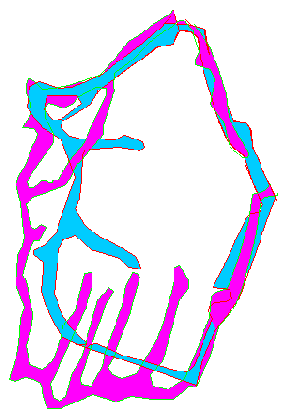
The Invisible Donut

Above is the engraving as published by S. Lwoff, with the exception of the color fill, of course. The generally agreed upon face is very interesting, and as it is a combination of two quite symmetrical pentagonal shapes. Rather than another obese Venus, this engraving reminds me more of the Russian "babushkas".



On the left, we see the standard
interpretation of this La Marche engraving. It is supposed to be the
classic obese Venus ( in clothes ).
On the right, we have one of
my own impressions from the same engraving. BTW, if the figure at
left is a that of a rotund woman, then why are there some specks on
the face, which look like a man's stubble? This could be another of
the numerous cases of "shaved" faces from La Marche. The
main face is too lean for the supposedly obese body.
Sometimes we don't see a dough-nut because of the hole..
The Venus draws attention away from the serpent, and it escapes undetected. The serpent's 3-D like head protrudes towards the viewer. It may look a "little" scary to some people. I'm not sure if anyone ever picked out this serpent before me (1985). This serpent is the dough-nut around the hole... It is an intelligent serpent, with beady eyes and drooping eyelids. It has a human head crown..
Pinocchio
A smaller Pinocchio like face appears at the back of the head of the first profile ... Pinocchio's head is enclosed in a transparent helmet. His orientation puts him into sync with the booted feet, in contrast with the main face. Since there are the boots, and the transparent helmet held by angular attachments to the bulbous, symmetric cloak or habit - could the cloak portray a suit of armor or a spacesuit? There is yet another vista available here. Imagine the bulbous suit as a steep hill. Is that a castle at the hilltop?

The castle is
accented in red. It crowns two heads. What is its symbolism here?
Is there competition between the two heads (for the castle), or are
they allied forces? Is the human head that of a king, whose castle it
once was? 
The
Scholar
In turning the image 180 degrees, the scholar's head becomes the main motif. The head is given by the nucleus of the 'Invisible Donut' engraving. The scholar also has a Pinocchio nose. Funny, but there also seems to be a plane doing a loop above his cranium.
In Poses,
there is a similar figure, inasmuch that it too directs its prayers
heavenwards. Repetition of the same motif in other engravings would
make it that much more real. The figure of 'Pinocchio' seems to have
acquired an ethereal body showing through the praying figure, as if
this scene were one of those 'marriage certificates', discussed in
literature. 
Mug
Shots
Below is an interesting experiment with the Scholar.
Bottom left shows the result of mirroring the face over its vertical
axis. The rest are interpretations. IMHO, these faces express
particular emotionality. They remind me of stages in my life - top
left could be me walking out of Mac Donald's years fifteen years
ago; the vacuous one on the right could be me years later, as a
vegetarian walking by the same eatery, and furiously sucking in the
'heavenly' aroma.. (just kidding).
Is the Scholar from the
previous page a humorous self-portrait? By the way, Scholar's head
is by far the largest thing in the engraving. It is the obese Venus'
big body in reverse. * In summation, the Invisible Donut shows the
gamut of classic La Marche features.